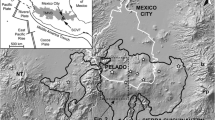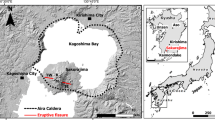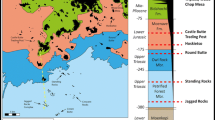Abstract
The submarine eruption of a new small knoll, which was named “Teishi knoll”, off eastern Izu Peninsula behind the Izu-Mariana arc occurred in the evening of 13 July 1989. This is the first historic eruption of the Higashi-Izu monogenetic volcano group. The eruption of 13 July followed an earthquake swarm near Ito city starting on 30 June. There were subsequent volcanic tremors on 11 and 12 July, and the formation of the Teishi knoll on the 100 m deep insular shelf 4 km northeast of Ito city. There were five submarine explosions, which were characterized by intermittent domelike bulges of water and black tephra-jets, which occurred within 10 min on 13 July. Ejecta of the eruption was small in volume and composed of highly crystalline basalt scoria, highly vesiculated “pumice”, and lithic material. Petrographical features suggest that the “pumice” was produced by vesiculation of reheated wet felsic tuff of an older formation. The Teishi knoll, before the eruption, was a circular dome, 450 m across and 25 m high, with steep sides and a flat summit. Considerations of submarine topographic change indicate the knoll was raised by sill-like intrusion of 106 m3 of magma beneath a 30 m thick sediment blanket. This shallow intrusion is assumed to have started on 11 July when volcanic tremors were observed for the first time, but there was no indications of violent interaction between wet host sediments and intruding magma. The submarine eruption of 13 July appears to have been Friggered by a major lowering of the magma-column. The basalt scoria, having crystal-contents of more than 60%, is assumed to be derived from the cooled plastic margin of the shallow intrusive body. However, glassy scoria, which would indicate the interaction between hot fluidal magma and external water, was not observed. A scenario for the 1989 submarine eruption is as follows. When rapid subsidence of the hot interior of the intrusive magma occurred, reduced pressure caused the implosion of cooled plastic magma, adjacent pressurized, hot host material, and wet sediment. The mixing of these materials triggered the vigorous vapor explosions.
Similar content being viewed by others
References
Aramaki S, Hamuro K (1977) Geology of the Higashi-Izu monogenetic volcano group. Bull Earthq Res Inst, Univ Tokyo 52:235–278 (in Japanese with English abstract)
Board SJ, Clare AJ, Duffey RB, Hall RS, Poole DH (1971) An experimental study of energy transfer processes relevant to thermal explosions. Int J Heat Mass Transfer 14:1631–1641
Board SJ, Farmer CL, Poole DH (1974) Fragmentation in thermal explosions. Int J Heat Mass Transfer 17:331–339
Busby-Spera CJ, White DL (1987) Variation in peperite textures associated with differing host-sediment properties. Bull Volcanol 49:765–775
Colgate SA, Sigurgeirsson T (1973) Dynamic mixing of water and lava. Nature 244:552–555
Decker RW, Christiansen RL (1984) Explosive eruptions of Kilauea volcano, Hawaii. In: Explosive volcanism. National Academy Press, Washington DC, pp 122–132
Delaney PT (1982) Rapid intrusion of magma into wet rock: groundwater flow due to pore pressure increases. J Geophys Res 87 (B9):7739–7756
Einsele G (1982) Mechanism of sill intrusion into soft sediment and expulsion of pore water. Init Rept Deep Sea Drilling Proj 64:1169–1176
Fauske HK (1973) On the mechanism of uranium dioxide-sodium explosive interactions. Nucl Sci Eng 51:95–101
Fujii T, Aramaki S, Kaneko T, Kawanabe Y, Takahashi M, Nakayama Y, Hirabayashi J, Fukuoka T (1989) Petrology of the ejecta of 1989 submarine eruption off eastern Izu peninsula (abstract). Bull Volcanol Soc Japan 2nd ser 34:317–318 (in Japanese)
Hamuro K (1978) Geology of Omuroyama volcano group. J Geol Soc Japan 84:433–444 (in Japanese with English abstract)
Hamuro K (1985) Petrology of the Higashi-Izu monogenetic volcano group. Bull Earthq Res Inst Univ Tokyo 60:335–400
Heiken G (1972) Morphology and petrography of volcanic ashes. Geol Soc Am Bull 83:1961–1988
Heiken G, Wohletz KH (1985) Volcanic Ash. University of California Press, Berkeley, 246 pp
Ito T, Matsumoto R, Kano K, Sakuyama M (1984) Welding of acidic tuff and altered rhyolite fragments caused by the intrusion of magma — Examples in the Neogene Shiraham Group in the southern part of Izu Peninsula, central Japan —. J Geol Soc Japan 90:191–205 (Japanese with English abstract)
Kato S, Tsuchide M, Observation Team of the Hydrographic Department (1990) 1989 submarine eruption and topographic change of the Teishi knoll off eastern Izu Peninsula. J Geogr Tokyo Geogr Soc 99:132–141 (in Japanese)
Komiya M (1990) Erarthquake and eruption off East Izu Peninsula. J Geogr Tokyo Geogr Soc 99:124–131 (Japanese)
Kokelaar BP (1983) The mechanism of Surtseyan volcanism. J Geol Soc London 140:939–944
Lonsdale P, Lawver LA (1980) Immature plate boundary zone studied with a submersible in the Gulf of California. Geol Soc Am Bull 91:555–569
Marsh BD (1981) On the crystallinity, probability of occurrence, and rheology of lava and magma. Contrib Mineral Petrol 78:85–98
Mogi K (1958) Relations between the eruptions of various volcanoes and the deformation of the ground surfaces around them. Bull Earthq Res Inst Univ Tokyo 36:99–134
Nairn IA, Wood CP, Hewson CAY (1979) Phreatic eruptions of Ruapehu: April 1975. NZ J Geol Geophy 22:155–173
Nishimura T, Ueki S, Morita Y, Hamaguchi H (1989) Volcanic tremor associated with the Teishi-Kaikyu eruption, off the Izu peninsula (abstract). Bull Volcanol Soc Japan 2nd ser 34:313–314 (Japanese)
Oh MD, Corradini ML (1987) A propagation/expansion model for large scale vapor explosions. Nucl Sci Eng 95:225–240
Ono K, Soya T, Suto S, Uto K, Yamamoto T (1990) Products of the 1989 submarine eruption off Ito, east coast of Izu Peninsula. J Geogr Tokyo Geogr Soc 99:142–146 (in Japanese)
Peterson DW (1976) Processes of volcanic island growth, Kilauea volcano, Hawaii, 1969–1973. In: Ferran OG (ed) Andean and Antarctic volcanology problems. Internat Assoc Volcanol Chem Earth's Inter Sp Ser, pp 172–189
Pollard DD, Muller OH, Dockstader DR (1975) The form and growth of fingered sheet intrusions. Geol Soc Am Bull 86:351–363
Schmincke HU (1967) Fused tuff and peperites in south-central Washington. Geol Soc Am Bull 78:319–330
Shaw HR (1969) Rheology of basalt in the melting range. J Petrol 10:510–535
Sheridan MF Wohletz KH (1983) Hydrovolcanism: basic considerations and review. In: Sheridan MF, Barberi F (eds), Explosive volcanism. J Volcanol Geotherm Res 17:1–29
Sun RJ (1969) Theoretical size of hydraulically induced horizontal fractures and corresponding surface uplift in an idealized medium. J Geophys Res 74:5995–6011
Tada T (1990) Crustal deformation associated with the 1989 submarine eruption of Ito. J Geogr Tokyo Geogr Soc 99:147–152 (in Japanese)
Tsuneishi Y (1990) Automatic electronic distance measurement on the off-Ito swarm earthquakes and submarine eruption of July, 1989. J Geogr Tokyo Geogr Soc 99:153–165 (in Japanese with English abstract)
Ueki S, Morita Y, Horiuchi S, Nishimura T, Tanaka S, Hashimoto K, Hamaguchi H (1989) Precisely determined hypocenter distribution of the earthquakes following the eruption of Teishi-Kaikyu Volcano, off the Izu peninsula (abstract). J Volcanol Soc Japan 2nd ser 34:313 (in Japanese)
Wohletz KH (1986) Explosive magma-water interactions: thermodynamics, explosion mechanisms, and field studies. Bull Volcanol 48:245–264
Yamamoto T (1987) Fragmentation mechanisms of magma as hydrovolcanism: examples in the Neogene Hokutan Group, Tango Peninsula, western Honshu, Japan. Bull Volcanol Soc Japan 2nd ser 32:1–15 (in Japanese with English abstract)
Yamamoto T (1989) Characteristics and mechanism of phreatomagmatic explosion: application of vapor explosion model to volcanic eruptions. Bull Volcanol Soc Japan 2nd ser 34:41–56 (in Japanese with English abstract)
Author information
Authors and Affiliations
Rights and permissions
About this article
Cite this article
Yamamoto, T., Soya, T., Suto, S. et al. The 1989 submarine eruption off eastern Izu Peninsula, Japan: ejecta and eruption mechanisms. Bull Volcanol 53, 301–308 (1991). https://doi.org/10.1007/BF00414526
Received:
Accepted:
Issue Date:
DOI: https://doi.org/10.1007/BF00414526




